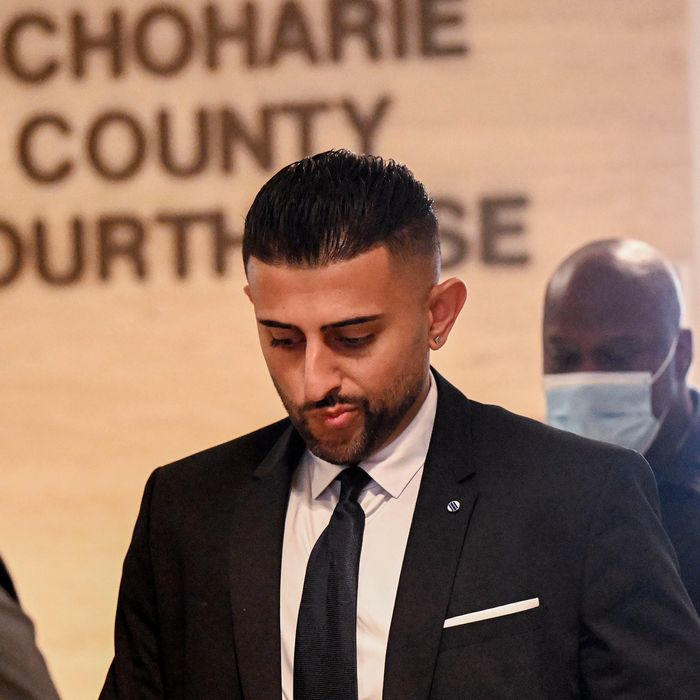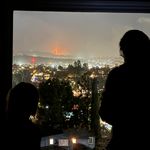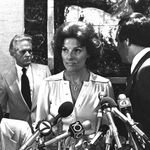
Last August in a stuffy courthouse upstate, the case of a runaway stretch limousine was supposed to be in its final phases.
Nauman Hussain, a 33-year-old professional paintballer and limousine-company owner, had already pleaded guilty to criminally negligent homicide for causing 20 deaths when, on October 6, 2018, a Ford Excursion with defective brakes owned by his family lost control on a steep country road in Schoharie, New York. Despite those deaths being directly attributable to the derelict vehicle they occurred in, Hussain’s plea included no prison time, to the outrage of many upstate New Yorkers.
One of those was State Supreme Court Justice Peter Lynch. A lantern-jawed 65-year-old known as a maverick, Lynch had inherited the case from his colleague who a year before had sobbed before the families of the crash victims as he approved the no-prison deal and subsequently retired. Lynch was supposed to be handling the final administrative motions of the plea when, in a Zeussian fit of rage, he tossed out the deal.
“I will not abide by the terms of this plea,” Lynch declared as families of the victims cheered, reporters gasped, and cell phones lit up across the Capital Region. Lee Kindlon, Albany’s premier defense attorney, held his head in his hands. The defendant, his brow for once knit in fear — an emotion conspicuously absent during his previous court appearances — listened as Lynch offered him a choice: up to four years in prison starting the moment he stood up from the defense table, or a trial.
“It’s about seven minutes to 12,” Lynch continued. “I’m going to give [you] till 12:15.”
Hussain chose a trial, and it began last month, to the amazement of Albany, where the story remains something of an obsession. News trucks and wire reporters came out of the hills to this secluded agricultural valley where little seems to have changed since the 1940s. Schoharie is 40 minutes from Albany, but with its collapsed barns and $7 hash-from-a-can breakfasts, it feels closer to the Rust Belt vibe of western New York — making it all the stranger to see area power players walking the streets. Outside the courthouse, reporters gossiped whether Joe Tacopina, the Trump attorney who defended the Hussain family previously, would arrive again in his Porsche Panamera. (Tacopina did not come to the trial.) Or whether the lawyers had agreed to rules excluding some of the more lurid material, such as pictures of the crash and the fact that the limo driver had been high, from the trial.
The trial opened last week after surviving a series of appeals to Lynch’s shock ruling. Tossing out another judge’s settled deal is more or less unheard of, which makes it par for the course with the Schoharie limo crash, where no aspect of the story is anything less than mind-exploding.
The accident was and remains America’s worst vehicular disaster since 2009, including plane crashes. A stretch limousine that had been customized to such an absurd length that mechanics who serviced it feared putting it on a hoist, lest it break in half, found itself with rapidly fading brakes on the steep hills of Schoharie. The passengers — 17 men and women in their 30s, many of whom had grown up together in the town of Amsterdam — had commissioned the limo on a Saturday morning to take them to Ommegang Brewery in Cooperstown for a birthday. It was a last-second call to the Hussains, after a previous reservation fell through, that put them in the Excursion, where some immediately sensed danger.
“The limo sounds like it’s going to explode,” 34-year-old Erin McGowan texted a friend. “The motor is making everyone deaf 😭😭😭😭” It’s not clear when the brakes failed, but according to Matthew Heller, a driver who followed the limo and testified during the trial, “Every time the brakes were pressed, there was a burning metal-on-metal smell.”
For reasons that have never been explained, the 31-foot limousine found itself on an uncertain, meandering journey away from the brewery. After idling at an intersection, it began rolling, possibly unable to stop itself, down NY-30, a road local truck drivers knew to avoid, and ended up slamming first into a parked SUV, then a streambed at over 100 miles per hour.
The crash killed four sisters (an entire generation of one family), two brothers, a recently married couple with two children (who were not aboard), and the father and husband of Jaclyn Schnurr, a college biology professor who testified during the trial that her family was on a weekend road trip and had just gotten out of their car to stretch their legs when she heard the limo’s molten brakes screeching. “It was just getting louder and louder,” said Schnurr. “I kept thinking, What is making that noise?”
The crash grievously wounded two small upstate communities, Schoharie and Amsterdam, where most of the passengers came from. It implicated a culture of impunity at several state agencies, especially the Department of Transportation, which had somehow allowed the limo to be on the road for years, carrying kids to prom and families to weddings despite being an abundantly visible health hazard to anyone who stepped inside. And it threatened to spotlight how the FBI ensnared Black and immigrant men in concocted terrorism plots with the help of Hussain’s father.
“We definitely feel it’s important to see and understand what role, if any, the FBI played in potentially aiding and abetting the [Hussain] family in keeping that limousine on the road,” Kevin Cushing told the Albany Times Union back in March. Cushing, whose son Patrick died in the crash, has become the unofficial voice of the victims’ families.
Even by the Gothic standards of “Smallbany,” the case involved an impressively entertaining roster of characters. There was Lynch, a Roman bust come to life, glowering from the bench and at times questioning witnesses more aggressively than the prosecution. After his surprise ruling last September, an appeal was sent to Appellate Division’s Third Department, where State Supreme Court Justice Michael C. Lynch — Peter Lynch’s twin brother — had to recuse himself. The Lynches, according to a defense lawyer I spoke to, “dominate the legal scene up here.”
There was Kindlon, the owner of a flawlessly shiny bald head well known to viewers of upstate evening news, who came up to me outside the Schoharie courthouse one day, thrust a muscled forearm toward my abdomen, and said through his teeth, “You look nice. Who are you?” A former marine, he seemed determined to command the landscape of the Schoharie courthouse as much as Lynch would allow. He berated witnesses, pillow-talked jurors, and made the opposing counsel, Schoharie district attorney Susan Mallery, look like, well, an overmatched small-town prosecutor from the tiniest county in the state.
The most intriguing family story line, of course, was that of the Hussains. For the crash, the boyish Nauman faced 20 counts of second-degree manslaughter as the limo company’s manager when the Excursion crashed. But was he actually in charge?
“My impression is that his father abandoned him,” defense attorney Samuel Braverman told me when I began reporting this story three years ago. “The father doesn’t care about anybody.” It was Shahed, the longtime operator of Albany-area gas stations and other small businesses, and not his paintballing son Nauman who owned Prestige Limousine, the Saratoga Springs company whose “egregious disregard for safety” caused the crash, according to a damning report by the National Transportation Safety Board. It was the father whose name was on falsified documents proving that Prestige went out of its way to misrepresent the colossal, bus-size Excursion as essentially an Uber so that it could avoid the much more rigorous safety inspections required of large vehicles.
Unfortunately, thanks to the Hussains’ weakness for impersonating each other in pinches and constantly switching names, no one but they knows who was actually in charge. (Nauman’s older brother Haris seems to have been less involved with the limo company. He instead ran a motel filled with indigent families where living standards were so low that a child nearly drowned in an open septic tank.) But there was no doubt that Shahed owned Prestige Limousine, raising the obvious question of why his son was wearing the ankle monitor.
Targeting Nauman was undeniably convenient. Shahed Hussain spent more than a decade as the FBI’s “superinformant” in the war on terror. When the FBI targeted an upstate mosque or an individual following 9/11, it contracted Hussain, who would impersonate a terrorist ringleader. Sometimes he worked from a script, sometimes he improvised. Winning recruits wasn’t his only skill; Hussain also controlled the hidden cameras and made strategic decisions on the fly, such as how much money to offer to blow up a car. And when it came time to seduce a jury, he knew exactly what to say — and perhaps more important, what not to say. At least seven people ended up in prison because of stings he was involved in. Four remain there.
Kindlon’s father, Terry, also a defense lawyer, once helped represent a pair of Muslim immigrants ensnared in one of those fake terror plots. Terry once vowed to do everything in his power to “destroy” Shahed, but in one of the more unexpected twists of the trial, he came out of retirement to help defend the Hussain family, although he never stepped foot in the courtroom.
When Shahed Hussain wasn’t charged over the limo wreck, many speculated that it was because he had been placed off-limits by the Feds. “If the government goes after him, he will simply say, ‘All right, I will tell everyone how we all knew these guys weren’t terrorists and the FBI decided to screw them anyway,’” said Steve Downs, a lawyer who helped Terry Kindlon. “They got in bed with the devil,” said Kevin Luibrand, a defense lawyer who represented a Bangladeshi pizzeria owner caught up in a terrorism sting. “He’s not a police officer. He’s just a bad guy. And they used this bad guy to groom people who were not necessarily bad at the time.”
Prestige Limousine was one of Shahed Hussain’s many small businesses, and it was an outlaw company. At one time, it operated a fleet of four vehicles, not one of which possessed operating authority. Prestige broke basic safety rules like requiring drug tests. Inspectors for the National Transportation Safety Board were stupefied by the state’s inaction, such as its refusal to confiscate Prestige’s license plates for breaking major safety rules and the way fines for breaking such rules magically disappeared. The Hussains were bulletproof. Which raises the question published in a headline by the Albany Times Union at the start of the trial: “How culpable is the FBI for the crash that killed 20 people in Schoharie?”
But the FBI never came up in the courtroom, except when Brian Chase, an accident-reconstruction specialist who frequently works for the bureau, took the stand. Chase told the jury that after thousands of vehicle autopsies, he’d never seen a carcass like that of the Excursion. “The odor of burned materials,” he said, “is something in all my years of experience I have never encountered.” He blamed the crash on “catastrophic brake failure attributed to a lack of proper maintenance.”
Other things that did not come up include Malik Riaz Hussain, the mysterious uncle who owned the Hussains’ violation-plagued motel for social-services recipients. Malik Riaz is unknown in the U.S., but in Pakistan he is considered the most powerful private citizen in the country. After the Times Union revealed that Malik Riaz had been funneling money to the Hussains, families of the crash victims included him in a civil suit against the Hussains. However, last spring a judge dropped him as a defendant during the discovery process. Part of the surrealism of the trial last week was knowing that as the Hussains’ legal drama unfolded, Malik Riaz was at the center of Pakistan’s worst social unrest in a generation, where a real-estate deal between him and former prime minister Imran Khan had led to Khan’s arrest.
Marijuana also did not come up, at least in the context of Scott Lisinicchia, the Excursion’s driver and a habitual pot smoker. (Weed did make an appearance on the third day of the trial, when Lynch dismissed a juror for arriving at court high.) Lisinicchia was a career driver who enjoyed his job and took pride in it, but he had a questionable safety record, and on the day of the crash, the amount of THC in his blood was reportedly “significant.” No marijuana user, whether medical or recreational, is allowed to drive a limousine. In fact, Lisinicchia had been ordered off the road the month before the crash in part for not having the certification he needed to drive such a large vehicle. This was a critical, head-scratching omission by prosecutors.
Most of the testimony focused on the Excursion’s brakes, which worked to the Hussains’ favor. True, someone — perhaps Nauman — once accidentally poured transmission fluid, not brake fluid, in them. That might have contributed to the crash. True, a state inspector tried and failed to get the Excursion off the road after finding other troubling signs of home repairs, such as pliers attached to a leaky brake line. “If you didn’t do it, then somebody did, and you need to check it out,” the inspector, Chad Smith, said he told Hussain.
The family had a working relationship with one of the Saratoga branches of Mavis Discount Tire, a national chain. When Nauman brought the Excursion to the shop to have its brakes repaired, Mavis charged for work it said it had performed, then authorized the Excursion to return to service — without actually doing the repairs, its mechanics and a former manager admitted on the witness stand.
“You knew — you knew on that day that that wasn’t true!” Kindlon thundered at Virgil Park, the former manager. “You knew on that day!” Park denied that he did and blamed his workers, who in turn blamed him. Thomas Klingman, a Mavis employee, testified that he allowed the limo to pass inspection without doing any inspection at all. “I’m not looking to get fired,” he said, citing pressure from Park.
Unlike having a chronically high, unlicensed driver, which can only be blamed on the owner, Mavis’s inaction turned the issue of the brakes into favorable terrain for a defense lawyer hoping to bog down a jury.
“The government has to establish that the actions of the defendant caused the death,” Luibrand told me. “And that’s a very difficult connection to make. There’s room to argue that Mavis deceived the defendant, and Mavis had the same level of contribution as did the defendants, if not more. It’s mushy.”
When I spoke to him last week, Luibrand predicted that the prosecution would try to “overwhelm the jury with the horror of it all” using pictures of the crash. “They’ll probably do that for a number of days,” he said. “The horror will allow the jury to maybe gloss over some of the proximate-cause issues.” Images of the crash, which killed 16 of the 18 occupants instantly, have always been tightly guarded. According to the National Transportation Safety Board report, “Due to the circumstances of the crash, little blood was available for testing,” which the reader is left to interpret.
But on Monday, DA Mallery inexplicably rested her case without showing a single picture of the carnage. After summoning Jaclyn Schnurr, the biology professor, who soberly recounted the moment of impact — after getting knocked down by what she described as a “white blur,” she saw her father-in-law, whom she had been chatting with a moment earlier, in a tree — Mallery called only two out of potentially dozens of other family members. Mallery’s performance has been savaged by local media almost since the day after the crash, and it only intensified during the trial. “The prosecution’s oft bumbling and stumbling presentation has stymied their own case and bolstered a defense that already had ample opportunity to shift blame away from Hussain,” wrote Andrew Waite of Schenectady’s Daily Gazette.
During summations on Tuesday, the always composed Kindlon tried to put on the performance of a lifetime, using his deepest basso profundo to rip into the prosecution. Sarcastic and theatrical, his arms flapping as his blond eyebrows writhed, he admitted that his client was a shabby businessman who “didn’t follow every rule and regulation.” However, he asserted, “Mr. Hussain had the honest and true belief that he had repaired the brakes and they were in fine working order.” Boldly inverting the popular narrative in Albany, where the Hussains were seen as untouchable, he called Nauman a victim of “powerful people who protect their own.”
“Do not be afraid of not guilty,” he boomed.
His adversary, the colorless, peckish Fred Rench, a hired gun brought in by Mallery, could not have contrasted more starkly. Rench shuffled to the podium carrying a stack of printed emails between Nauman Hussain and a state inspector, which he literally read word for word, repeatedly spelling out email addresses. The courthouse squirmed as he delayed the jury’s lunch for almost an hour with a 90-plus-minute soliloquy. Rench succeeded, however, through sheer monomania, in driving home a devastating point: As the emails he painstakingly read showed, the Hussains knowingly dodged rigorous inspections by the Department of Transportation — inspections that would inevitably have revealed the limo’s catastrophically compromised brakes. They knew, in other words, that they were breaking the rules, but they didn’t seem to care.
“That was a conscious choice of [Nauman’s], to disregard the risk he had created,” Rench asserted. “He sent that vehicle to Amsterdam. He chose that risk.”
On Wednesday, after less than a full day of deliberation, the jury returned its verdict and found Nauman Hussain guilty on all 20 counts of manslaughter.





























